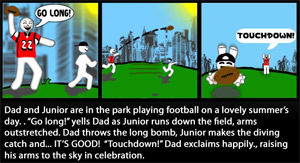| « Princess Puffytail, the Fairy Pirate | New Year, New Stories » |
Feature Tue Mar 23 2010
One-Shots: Josh Elder and Reading With Pictures
Name: Josh Elder
Job: Founder and Executive Director, Reading With Pictures, a nonprofit organization that advocates the use of comics in the classroom.
Age: 29
Education: Northwestern University, BS in Radio/Television/Film
Location: Irving Park
Hometown: Carmi, IL
Website: www.readingwithpictures.org, Kickstarter
Favorite place in Chicago: The Art Institute


Portrait by Jen Brazas
How are you involved in the comic book industry?
I started as a college intern in the Publicity and Editorial departments at DC Comics. Upon graduation, I had a brief stint as an Associate Editor at Wizard: The Comic Magazine. In 2005, I won the Grand Prize in TOKYOPOP's Rising Stars of Manga contest (think American Idol for cartoonists) with Mail Order Ninja, which was swiftly picked up as a book series and then a nationally syndicated comic strip.
That led to writing The Batman Strikes at DC Comics and StarCraft for Blizzard Entertainment. I'm currently working on a number of different projects of my own, as well as other licensed properties that I can't really talk about yet.
How did you get into reading comics? What about drawing them?
My mother -- a school librarian -- was reading to me as she did every night before putting me to bed. Usually that meant a chapter book or some classic kid lit, but that night, for reasons lost to antiquity, I got to choose the reading material. And like any red-blooded American male my age, I chose a comic. Issue number four of The Transformers to be precise.
Everything was going great. right up until mom's laryngitis caught up with her, causing her to lose her voice barely halfway through the issue. This was completely unacceptable. Optimus Prime was in a lot of danger, and I had to make sure he was going to be okay.
So I used the comic to teach myself how to read so I could finish the comic. And right from the beginning, I wanted to create my own comics.
What is Reading With Pictures all about?
Reading With Pictures is a nonprofit organization that advocates the use of comics in the classroom to promote literacy and improve educational outcomes for all students. We work with academics to cultivate groundbreaking research into the proper role of comics in education. We collaborate with cartoonists to produce exceptional graphic novel content for scholastic use. Most importantly, we partner with educators to develop a system of best practices for integrating comics into their curriculum.
How are you using Kickstarter to promote it?
We're using Kickstarter to sell pre-orders of our educational comics anthology, The Reading With Pictures Anthology Vol. 1. It's our "proof-of-concept" to the educational community that comics do belong in the classroom. We have stories by over 50 cartoonists (including me and Chicago's own Jeffrey Brown) with a cover by the lovely Chicago native Jill Thompson on the full-color, 192-page anthology.
The pre-orders are absolutely essential to getting us the funds we need to print the book at all, and it's the only way to guarantee a copy for your home, school or library. You can find out more on our Kickstarter site here.
Why are comic books important in schools? To childhood in general?
The case for comics in the classroom comes down to what I call The Three Es.
Engagement: Text imparts meaning through the reader's active engagement with written language. A comic imparts meaning through the reader's active engagement with written language and juxtaposed sequential images. And for there to be juxtaposition, there must also be a space between. Allow me to illustrate with this simple 3-panel comic strip.

Let's look at Panel 1 again. Dad has his arm cocked, ready to throw. Now in Panel 2, the ball is already in the air. Dad threw the ball, but you never saw it leave his hand. Or rather, you did see it leave his hand, you just saw it happen in your mind's eye rather than on the screen. The comic edited the narrative into a highlight reel of sorts, consigning all the extraneous information to the gutter and giving you just enough information to infer all the things it didn't actually show you. You have to put your mind in the gutter and read between the lines of each and every panel of even the simplest comic, or the comic simply won't get read.
Yet if comics require readers to fill in the gaps and put more work than usual into the reading process, why have comics proven so effective at reaching otherwise reluctant readers and students with learning impairments like autism and dyslexia? The answer is that it just doesn't feel like work to read a comic. Comics are more viscerally appealing and more immediately engaging than prose. Comics are, in a word, fun.
Efficiency: I'm going to show you the three-panel comic strip again, and below it will be text that describes exactly the same scene.

The same narrative information, only the comic took 1-2 seconds to read while the prose took more like 10-20 seconds. Every day, there's more to learn, but our class periods aren't getting any longer. But they won't have to if we can improve the efficiency of our instructional methods by an order of magnitude
Effectiveness: not that increasing efficiency matters if the students forget what they've read as soon as they're done reading it. Thankfully neurological experiments indicate that pairing complimentary images with text leads to increased comprehension and memory retention for both. With comics, you not only learn the material faster, you're also going to learn it better.
How are comics objectively viscerally, or instinctively, more appealing? I mean, some people aren't very visual, and would rather read words than look at pictures. How would you make a case for comics to people that prefer, well, Reading Without Pictures?
Using comics to teach language and vocabulary is just a more sophisticated version of that original image-and-language linking process. Like any language, comics has its own rules. Like any language, it's easy to learn those rules when you're young, but it grows progressively more difficult with age.
So the problem that people who "aren't very visual" have is that they were never taught the rules of visual language the way they were taught their ABCs...give them a simple comic where the panel transitions are obvious and intuitive. Give them comic strips or webcomics before you hand them something from Chris Ware. Let them walk a little bit before you ask them to run.
What does the future hold for RWP? What direction would you like to see it go in?
We plan to provide an intellectual framework that justifies the use of comics in the classroom, as well as the resources to help teachers make the best use of those comics.









